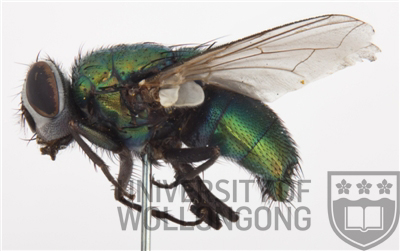Taxonomy
Family: Calliphoridae
Subfamily: Luciliinae
Genus: Lucilia Robineau-Desvoidy 1830
Species: cuprina (Wiedemann 1830)
The first- and second-instar larvae were described by Erzinçlioglu (1989) and O'Flynn and Moorhouse (1980). The third-instar larvae was described by Erzinçlioglu (1989) and Holloway (1991).
Biology
Lucilia cuprina is an extremely
common blowfly
in Australia. It can be frequently observed around garbage,
and is attracted to carrion. It is the most
common fly initiating myiasis in sheep and in
some areas is implicated in at least 90% of strikes
(Waterhouse and Paramonov 1950). Unlike its sister species
Lucilia sericata, L. cuprina prefers
the drier, more arid areas of Australia (Waterhouse and
Paramonov 1950). The species has been
rigorously studied due to the animal suffering and economic
losses attributed to sheep strikes initiated by it.
The species was introduced to Australia, with the Australian population probably comprising two sub-species, or a hybridisation of the two sub-species. Norris (1990) describes the invasion of the species onto the continent. Wallman et al. (2005) suggest the two sub-species actually constitute separate species based on genetic distinctiveness of the Western Australian and eastern-Australian populations.
Distribution
Lucilia cuprina has been
recorded from all Australian states and territories.
Relevant Literature
Erzinçlioglu, Y.Z. (1989) The early
larval instars of Lucilia
sericata and Lucilia
cuprina (Diptera: Calliphoridae): myiasis blowflies
of Africa and Australia. Journal of Natural History 23, 1133-1136.
Fuller, M.E. (1934)
The insect inhabitants of carrion: a study in animal
ecology. Council for
Scientific and Industrial Research, Australia, Bulletin
82, 1-63.
Gilmour, D., Waterhouse, D.F. and McIntyre, G.A.
(1946) An account of experiments undertaken to determine
the natural population density of
the sheep blowfly, Lucilia cuprina
Weid. Bulletin of
the Council for Scientific and Industrial Research 195, 1-39.
Holloway, B.A. (1991)
Identification of third-instar larvae of flystrike and
carrion-associated blowflies in New Zealand (Diptera:
Calliphoridae). New
Zealand Entomologist 14, 24-28.
Norris,
K.R. (1990) Evidence of the multiple exotic origin of
Australian populations of the sheep blowfly, Lucilia cuprina
(Wiedemann) (Diptera: Calliphoridae). Australian Journal of
Zoology 38, 635-648.
O'Flynn, M.A. and
Moorhouse, D.E. (1980) Identification of early immature
stages of some common Queensland carrion flies. Journal of the
Australian Entomological Society 19, 53-61.
Wallman,
J.F., Leys, R. and Hogendoorn, K. (2005) Molecular
systematics of Australian carrion-breeding blowflies
(Diptera:
Calliphoridae) based on mitochondrial DNA. Invertebrate
Systematics 19, 1-15.
Waterhouse, D.F. (1947)
The relative importance of live sheep and carrion as
breeding grounds for the Australian sheep blowfly Lucilia cuprina. Bulletin of the
Council for Scientific and Industrial Research 217, 1-31.
Waterhouse, D.F. and Paramonov, S.J. (1950) The status of the two species of Lucilia (Diptera, Calliphoridae) attacking sheep in Australia. Australian Journal of Scientific Research. Series B. 3 310-336.


